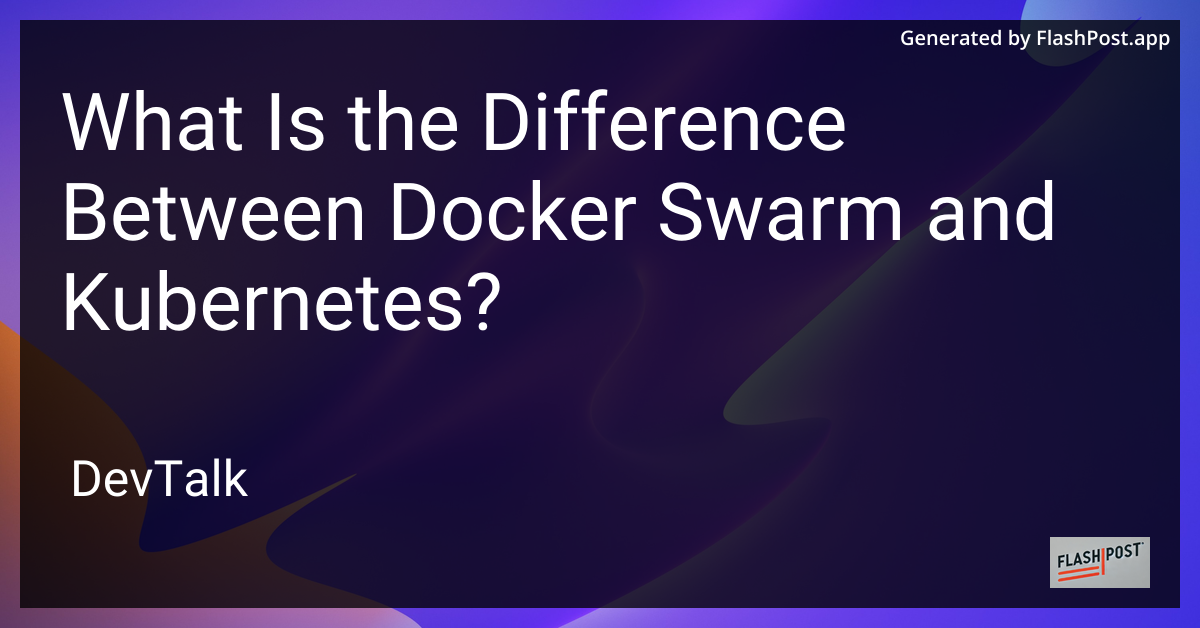What Is the Difference Between Docker Swarm and Kubernetes?

Understanding the Difference Between Docker Swarm and Kubernetes
In the rapidly evolving world of container orchestration, Docker Swarm and Kubernetes stand out as two of the most popular tools.
Both of these platforms help manage containers efficiently, but they differ significantly in terms of features, scalability, and complexity. This article delves into the key differences between Docker Swarm and Kubernetes, helping you choose the right tool for your needs.
What is Docker Swarm?
Docker Swarm is a native clustering and scheduling tool for Docker containers. It is designed to turn a pool of Docker engines into a single virtual Docker engine. By using Docker Swarm, developers can manage their containerized application as if it were a single instance, regardless of the number of machines involved.
Key Features of Docker Swarm
- Ease of Use: Docker Swarm uses the same command-line interface (CLI) of Docker, ensuring an easy learning curve for those already familiar with Docker.
- Native Integration: Being a native Docker tool, it integrates seamlessly with other Docker tools.
- Simplified Setup: Setting up a swarm is straightforward and can be done relatively quickly.
- Automatic Load Balancing: Automatically balances the incoming traffic to ensure that the cluster’s resources are utilized effectively.
What is Kubernetes?
Kubernetes, often abbreviated as K8s, is an open-source platform designed to automate deploying, scaling, and operating application containers. Google originally developed Kubernetes, now maintained by the Cloud Native Computing Foundation (CNCF).
Key Features of Kubernetes
- Advanced Scheduling: Provides advanced scheduling capabilities, allowing for more complex and custom container configurations.
- Robust Ecosystem: Supports a wide array of extensions and community-contributed tools, including Helm for package management.
- Scalability: Designed for operability at scale, it's ideal for high-demand enterprise environments.
- Self-Healing: Automatically restarts failed containers, replaces and reschedules containers when nodes die, and manages local storage.
Key Differences Between Docker Swarm and Kubernetes
-
Complexity and Learning Curve: Docker Swarm is known for its simplicity and ease of use, making it a great choice for small to mid-sized applications. Kubernetes, while more complex, offers extensive features and is better suited for larger applications requiring high availability and scalability.
-
Community and Support: Kubernetes boasts a larger, more active community with more contributions and support resources. Docker Swarm, while backed by Docker, does not have as expansive a community.
-
Networking and Load Balancing: Docker Swarm has simplistic networking and load balancing. Kubernetes offers robust networking capabilities with multiple networking solutions.
-
Scaling: Kubernetes provides superior scaling capabilities, making it suitable for enterprise-level applications with large clusters. Docker Swarm, although capable, does not scale as effectively as Kubernetes.
-
Rolling Updates and Rollbacks: Kubernetes provides out-of-the-box support for rolling updates and rollbacks, facilitating smoother transitions. Docker Swarm requires manual setup for similar capabilities.
Conclusion: Which Should You Choose?
Your choice between Docker Swarm and Kubernetes ultimately depends on your specific needs. If you seek simplicity and fast deployment for smaller setups, Docker Swarm might be the right fit. However, for large, complex applications requiring robust scalability, Kubernetes is likely the better option.
Further Reading:
- Learn how to install Kubernetes on Debian 11 by following this Kubernetes installation guide for Debian 11.
- Discover how to manage Kubernetes Helm chart configurations in this comprehensive guide on Kubernetes Helm chart configuration.
- Update your knowledge for future upgrades with this tutorial on Kubernetes Helm chart updates in 2025.
Both Docker Swarm and Kubernetes are powerful tools with unique strengths. Depending on your application's requirements and your team’s skill set, you can determine which solution aligns best with your goals. Happy containerizing!